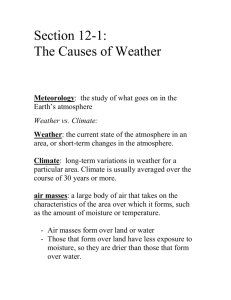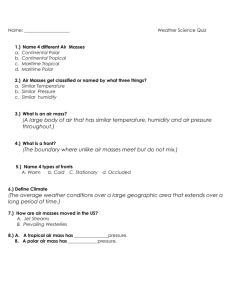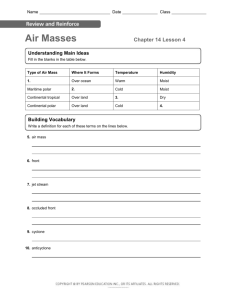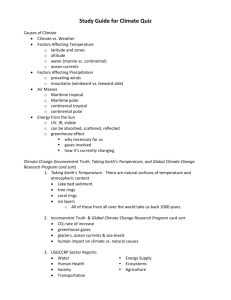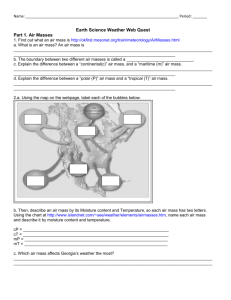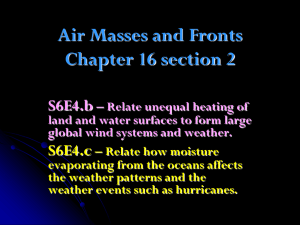Weather Map Analysis
advertisement
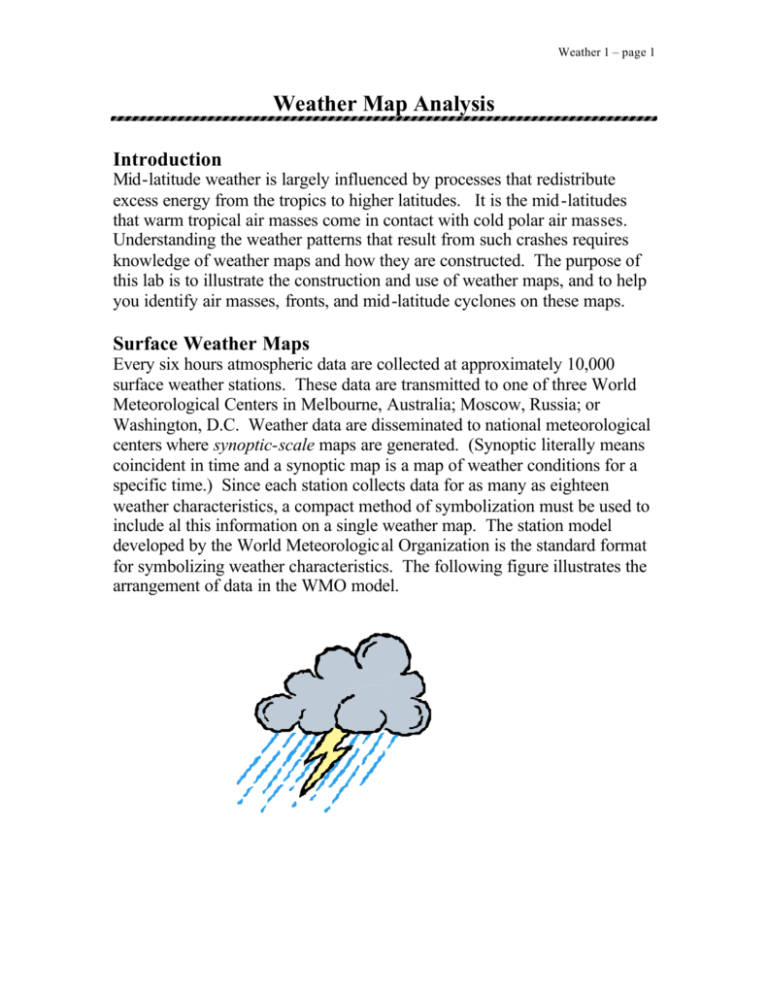
Weather 1 – page 1 Weather Map Analysis Introduction Mid-latitude weather is largely influenced by processes that redistribute excess energy from the tropics to higher latitudes. It is the mid-latitudes that warm tropical air masses come in contact with cold polar air masses. Understanding the weather patterns that result from such crashes requires knowledge of weather maps and how they are constructed. The purpose of this lab is to illustrate the construction and use of weather maps, and to help you identify air masses, fronts, and mid-latitude cyclones on these maps. Surface Weather Maps Every six hours atmospheric data are collected at approximately 10,000 surface weather stations. These data are transmitted to one of three World Meteorological Centers in Melbourne, Australia; Moscow, Russia; or Washington, D.C. Weather data are disseminated to national meteorological centers where synoptic-scale maps are generated. (Synoptic literally means coincident in time and a synoptic map is a map of weather conditions for a specific time.) Since each station collects data for as many as eighteen weather characteristics, a compact method of symbolization must be used to include al this information on a single weather map. The station model developed by the World Meteorological Organization is the standard format for symbolizing weather characteristics. The following figure illustrates the arrangement of data in the WMO model. Weather 1 – page 2 Weather 1 – page 3 Weather 1 – page 4 Weather maps become most useful when their information is analyzed in some fashion. One means of analysis is to highlight the spatial patterns of specific variables. This can be done by consulting isolines (lines of constant value). In the figure below, an isotherm (line of constant temperature) is constructed through 80oF. 2. Complete the analysis in the figure above by construction isotherms at 70oF and 75 oF. Weather 1 – page 5 Drawing lines in the earlier example was straightforward since the temperature at each station was exactly 80o, 75o, or 70o F. Since such patterns rarely occur in nature it is often necessary to interpolate between points. For example, we may want to draw a 1012mb isobar (line of constant barometric pressure) using the following station data: 140 130 100 125 To interpret the data for barometric pressure, you first need to change the data to a more meaningful number. First, place a decimal point before the final number. For example, 125 would become 12.5. Then if the first two numbers are less than 50, place a 10 in front of the numbers; otherwise place a 9 in front. In our example, 12.5, the first two numbers are 12, which is less than 50. We then place a 10 in front, and the barometric pressure is actually 1012.5 millibars. In a simple interpolation scheme we might decide that 1012 Mb is exactly between 1010.0 and 1014.0 Mb and would indicate this position with a small “x.” A value of 1012 Mb would also exist two-thirds the distance between 1010.0 and 1013.0 Mb, and four-fifths the distance between 1010.0 and 1012.5 Mb. 140 x 130 100 x x 125 The “x’s” we draw represent new data points through which we can make a 1012 Mb isobar. Weather 1 – page 6 3. Construct Isotherms at 4 o F intervals in the simplified weather map below: Weather 1 – page 7 Air Masses and Fronts An air mass is a large body of air with relatively uniform temperature and humidity characteristics. Air masses form over large land or water surfaces and take on the temperature and moisture characteristics of these surfaces where they remain stationary for days, or even weeks. Their temperature characteristics are classified as maritime or continental. The following types of air masses result: • Maritime equatorial (mE) • Maritime tropical (mT) • Maritime polar (mP) • Continental tropical ( cT) • Continental polar (cP) • Continental arctic (cA) • (Continental equatorial and maritime arctic air masses are rarely found and therefore are not listed.) Air masses often migrate from their source regions and affect midlatitude weather. Examine the diagram below showing air masses affecting North America. 4. Based on the source regions shown by the ovals, use the appropriate two-letter code to indicate each air mass type. Weather 1 – page 8 The boundary between two unlike air masses is called a front and can be identified by any of the following characteristics: • a sharp temperature gradient • a sharp moisture gradient • a sharp change in wind direction 5. Draw the frontal boundary in the figure below: Weather 1 – page 9 Using the map below: a. Draw isobars at 4mb intervals (use 1004, 1008, 1012, 1016) b. Label the low pressure center with an “L” c. Label the air masses (maritime tropical, continental polar) d. Draw the warm and cold fronts


